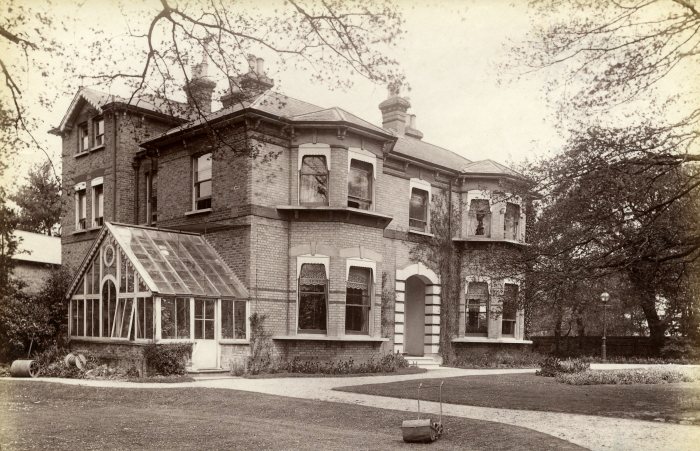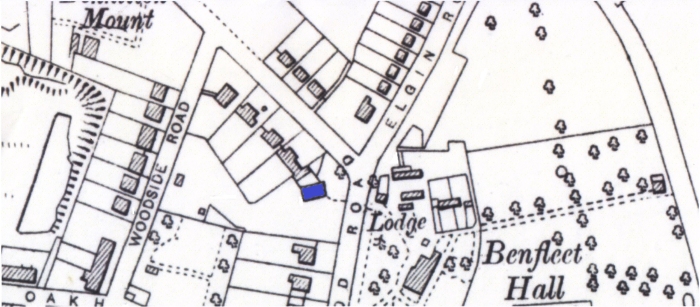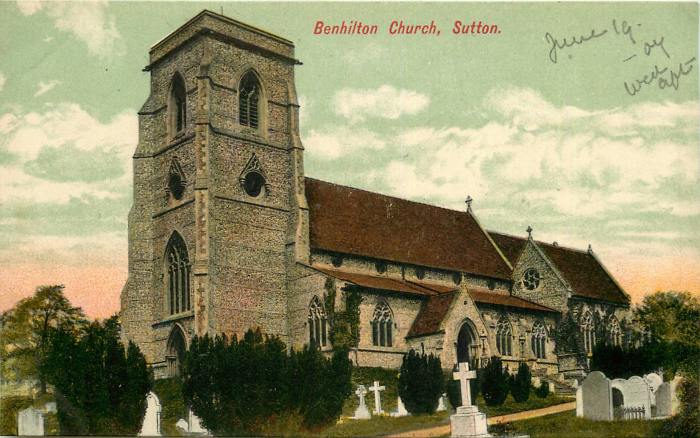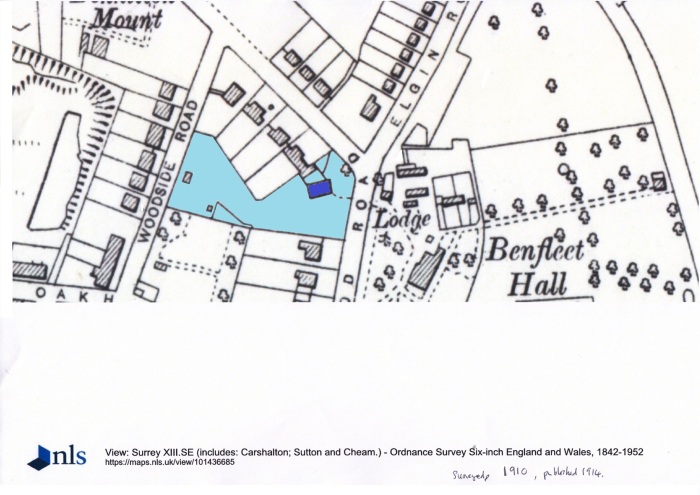If you caught the first episode of the new and wonderful BBC series A House Through Time earlier this week, you may be considering the life of your own home, and thinking about how to go about tracing this back.
Indeed, Clive, the author of our own ‘House Through the Ages’ story, serialised here over recent weeks, credits this show as his inspiration … ”I became fascinated by David Olusoga’s TV series A House through Time, which particularly appealed to my sense of place, and the relationship between a place and the people who lived there over the years. While aware that a huge amount of background research must have gone into a single series (and how many houses did not make the grade?), I wondered if a similar thing could be done on a smaller scale here in Sutton. I thought that it might be interesting to show, not only the outcomes of my research, but also the way it developed, with all the problems, pitfalls and mistakes that I would inevitably encounter.’
The Hilton, outlined in our series, is a property that no longer exists. Its history interested our author, partly because its foundations lay across his own back garden, and partly building on knowledge gleaned from a school history project undertaken by one of his children. Just as with the BBC property in Bristol, the size and grandeur of the property pretty much ensured some wealthy and probably influential residents, but how traceable, and interesting these would be, was unknown to Clive until work began.
Todays episode is the penultimate of our series. Next week in our final post, Clive reflects briefly on some of the challenges of this kind of exercise; on how to get started, how to source relevant information, on the challenges he encountered and on where to find relevant information. If you’re only now joining us now, I’d advise you have a look back at episode one to see how this project originated. What is clear, reading through them all, is that from such simple beginnings as the perusal of local directories, it was necessary for Clive to throw his net far and wide to capture such a fascinating and comprehensive history.
If you have been inspired by the programme to have a look at your own house history, join us next week and consider getting in touch. While we don’t offer a research service, we have a team of volunteers, including Clive, who are happy to help you get started, and we are happy to advise on the sources we have that can aid your search.
Let us now move on….to the final residents of Clive’s research journey, and the penultimate puzzle piece in the story of The Hilton.

Photograph of The Hilton in 1903, from the south. Benhill Wood Road is behind the trees to the right. Image from Sutton Archives Local Studies Collection

Extract from map of the area in 1910 (O.S. Six-inch map, published 1914). The Hilton is shown coloured blue.
The last of our families to live at The Hilton was the Hickman family, who also lived there the longest (1901 to 1926). The head of the household was Arthur Edwin Hickman (AEH), who had been born in the Lambeth district in 1859, but not baptised until 1870, when he, along with several siblings, was baptised at St Saviour’s Ruskin Park in south-east London. They were then living at 25 The Terrace, Kennington.
Arthur Hickman’s move to The Hilton marks a generational shift, as his predecessor, Dr Ambrose Hunt, had been born in 1824. AEH appeared in the 1881 Census as a lodger in Aldershot, working as a grocer’s assistant. In view of his later career (see below) this seems unlikely, and may be a case of mistaken identity.
We are on firmer ground in 1883, when he was back at 25 The Terrace, Kennington, and married Mary Harriet Parry from Llanwrog, Montgomeryshire, who was a few months younger than him. Their family was large by modern standards (six children), but smaller than the Kennedy’s (twelve children) and the Hunt’s (eleven children) (see Episodes 2 and 5 respectively). The children were: Ruby (aka Reuben) Mary Parry (1884), Mary Daphne (1887), Arthur Kendrick (1892), Florence Enid (1898), Gordon David (1901) and Joan Elizabeth (1905). All were born in Sutton except for Ruby (born in Dulwich district) and possibly Mary (the 1891 Census listed her as born in Dulwich but the 1939 Registration said Sutton; I prefer the former because the source is much closer to her date of birth). I noticed that the interval between the first and last births (21 years) is about the same as for the Kennedys (17 years) and the Hunts (20 years), but the births are more widely spread.
AEH’s career appears to have been uneventful. In three successive Censuses (1891, 1901, 1911) he was listed as a stockbroker. In 1924 he re-applied for admission to the Stock Exchange; he appears to have succeeded because the 1939 Registration listed him as stockbroker (retired). It’s not clear to me why his re-admission was necessary; is there a deeper story here, or was it connected to his reaching the age of 65?
The family first appeared in Sutton in 1891 (unless Mary was born there in 1887, see above), living at Camden House, three doors along Benhill Wood Road from The Hilton, almost at the corner of Woodside Road. They seem to have lived there until 1901, when Pile’s Directory listed AEH at that address, although the 1901 Census (carried out on 31st March) showed them at The Hilton. Their address in the 1901 Census was given as Woodside Road (The Hilton); this can be explained because at that date the garden of The Hilton ran from Benhill Wood Road to Woodside Road, so its address could have been in either. Either they moved house early in the year, or Pile’s Directory was slightly behind the times. A further point of confusion is that the family were called Heckman in that Census, but their first names and ages all match, so it is clear that they are really the Hickmans.
They lived at The Hilton until at least 1926, when AEH was on the Electoral Register at that address, but by 1935 they had moved to a house called Glenthorne on the south side of Cheam Road. In the 1939 Registration their address was given as 23 Cheam Road; this may well be the same as Glenthorne. Sutton Baptist Church, which was built in 1934, was number 31 Cheam Road, so they must have lived next door (probably where the church’s car park is now, because Glenthorne was east of Sutton Park Road). From at least 1891 to 1939, AEH’s sister, Florence May Hickman, lived with the family.

Image of All Saints Benhilton c1907 reproduced courtesy of Michael Jeffries/Flickr CC-by-NC
The family seems to have had a strong connection with the church of All Saints, Benhilton. Both Arthur Kendrick and Gordon were baptised there while they were living at The Hilton, Ruby was married there in 1914 (see below) and her daughter Barbara was baptised there in 1915, although she was born in Bexley. Finally, both Ruby (died 1930) and Mary Harriet (died 1935) were buried there.
Mary Harriet also maintained a strong connection with her home church at Llanwrog. For example, in July 1896 she served on the Committee for the Llanwrog Church Restoration Bazaar, which took place nearby in Caersws. She and Ruby helped with stalls at the Bazaar, and Ruby also took part in the accompanying concert. This suggests an ongoing and regular connection, not just a one-off occasion. I wonder if she came back with the children each summer, perhaps to get them out of London.
What did the members of the family do? Arthur Kendrick was a boarder at Clifton College, Bristol, in 1911, where he played cricket and tennis for the school, and where Ruby and Mary Daphne may have visited him. He went on to be a student at Trinity College Oxford from 1911 to 1914, and played cricket for his college. He joined the London Rifle Brigade in August 1914 and was commissioned as a Second Lieutenant in the Royal Welsh Fusiliers in March 1915 (remember his mother was Welsh). After serving in both Flanders and Gallipoli, he died in action near Kut (now in Iraq) in April 1916.
Gordon, by contrast, was too young for the War and became a stockbroker like his father. In 1933 he married Charlotte Carpenter, but by the 1939 Registration he was living at 23 Cheam Road with his father, Mary Daphne, Florence Enid and his aunt Florence May, He died in 1971 in Rudgwick, Sussex.
I am unable to trace what happened to Charlotte.
Ruby married Ernest Spencer Nowill, son of a cutlery manufacturer from Sydenham, in 1914. Ernest joined the London Regiment in 1916 as a 2nd Lieutenant and survived the War. After the War, they appear to have lived locally (in the Epsom district, which included Sutton). Ruby died in 1930 at the young age of 45 and (see above) was buried at All Saints, Benhilton. Ernest appears to have re-married, and died at Grasmere in 1943.
Mary Daphne seems to have lived with her parents until at least the 1939 Registration, when she was listed as a cake maker. She died in 1961 at the age of 73 in the Horsham district (probably Rudgwick, where Gordon lived until 1971 (see above).
Florence Enid joined the Civil Service in 1923, working in the Clerical Class for the Board of Education. She was still living in Cheam Road with the family at the 1939 Registration, and still working as a civil servant. She was the last of her generation to die, in 1981 at the age of 83.
The youngest, Joan, is potentially the most interesting of the sisters. After the 1911 Census I can’t trace her until 1964, when she was Chief Herbarium Clerk and Senior Indexer at the Commonwealth Mycological Institute, Kew Gardens [mycology is the study of fungi]. This sounds like a quite senior non-academic post. She died 1974 in the Horsham district, probably also at Rudgwick (see above).
Substantial changes took place to the setting of The Hilton between 1910 and 1933-34. Between these dates the house lost most of its garden. Six semi-detached houses were built along its former Woodside Road frontage, cutting off access. A detached house was built close to the north side of The Hilton, between it and Selborne House; initially numbered 41A, it is now 41 Benhill Wood Road.
Another house is shown to the south, on the location of the present numbers 35 and 37, although from its shape it does not appear to be the same building. The overall effect was to reduce The Hilton’s garden to about 25% of its original size, implying a significance reduction in status. Were the Hickmans selling off land in order to be able to afford to continue living here?


The Hilton in 1910 (top) and 1933-34 (bottom). The house is shaded dark blue and the garden light blue
Join us next week for the final episode of this series when Clive reflects on his experience of undertaking a house history and offers some tips to anyone looking to embark on a similar piece of research…



You may already be aware of this, but the Stock Exchange membership applications are held at Guildhall Library and managed by London Metropolitan Archives. Those for 1802-1924 are available on Ancestry https://www.ancestry.co.uk/search/collections/61169/ . You will see that re-application is common and not necessarily significant.
LikeLike
Thanks Philippa – will be sure to pass this along to Clive. I wasn’t aware of this. Very helpful – thanks.
LikeLike